Band Chamber Music performance week
This week, the Band Department completed our Chamber Music performance unit. The students were allocated to a chamber group last term, with the goal to craft a cohesive ensemble that culminated in a performance this week. In Chamber Music, the students are encouraged to work independently of the teachers to create their small group performance—focusing on stage etiquette, intonation, articulation, dynamic contrast, and overall communication. The students are individually responsible for a unique part within their ensemble, which encourages them to contribute towards a common goal that is bigger than themselves. Taking on responsibility and ownership of an individual part within their group is a crucial skill to develop for all young musicians.
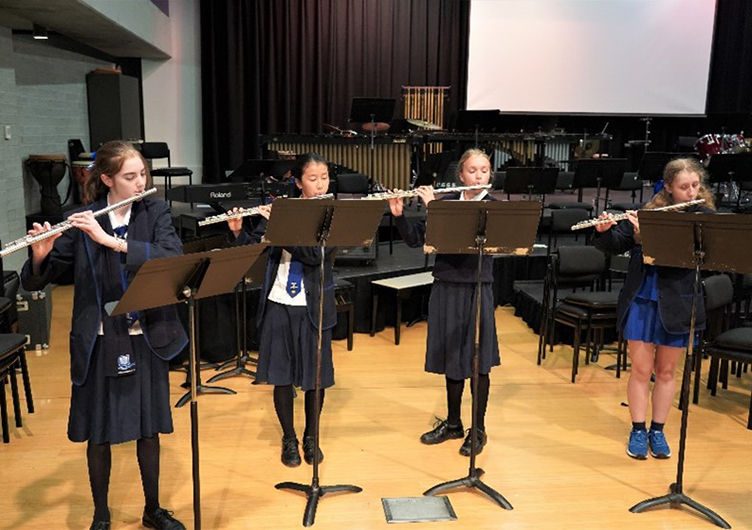
Anna Hodge(8L), Hannah Sun (9W), Abigail Buck (9H), and Amelia Loye (9H)
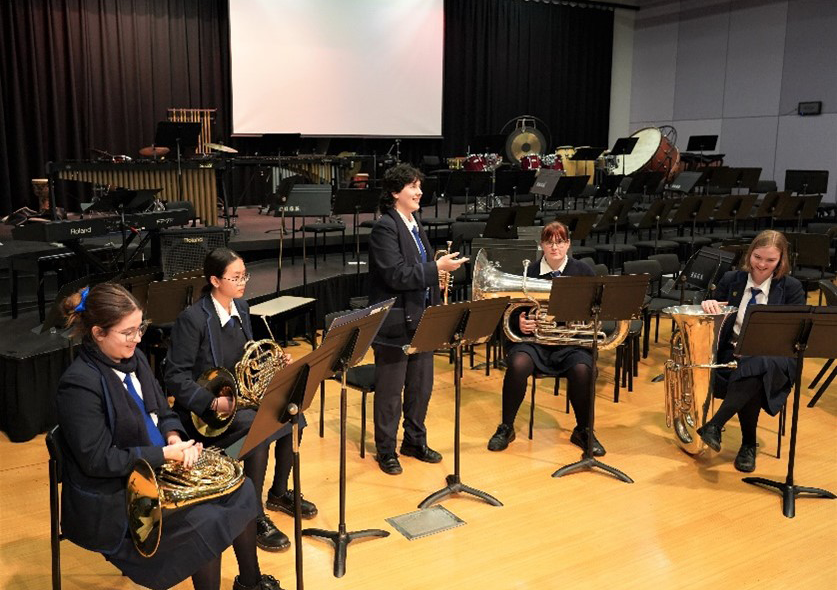
Jaimee Jessop (9R), Trish Chow (11H), Leah Diamond (11E), Samara Kohn (12L), and Dorothy Rae (10G)
Intermediate Strings Festival
On Monday and Tuesday afternoons this week, students from Albinoni Strings, Bartok Strings and Copland Strings participated in the Intermediate String Festival, hosted by BGS. Students have been working hard this term to prepare new repertoire in their weekly rehearsals and the festival culminated in a concert on Tuesday night with a performance by students from BGGS, BGS and Somerville House.
- Students from Copland Strings, conducted by our very own Ms Sharp, performed the beautiful, dance-like Aeolius by Margaret Fenske and the rousing Fiddlin’ to Freedom by Timo Javela
- Conducted by guest teacher, Ms Bastos, students from Bartok Strings presented a very stirring performance of Dramatic Essay by Mark Williams and an exciting rendition of Riders of Rohan by Keith Sharp
- Students from Albinoni Strings worked with Mr Chin to perform the beautiful, lilting Windward Waltz by Timo Javela and The Hunt from Deerpath Triptych
All 300 students then joined together as the Combined Festival Orchestra and were conducted by Mr Zorzetto. They presented a wonderous performance of Rainbow by Stephen Chin, debuted a new work titled Winter Sunshine, by Keith Sharp, and finished off the night with a hilariously, spicy rendition of Tijuana Taxi arranged by Larry Moore.
The festival was a great success and gave our students the opportunity to work with many new peer performers, engage with different guest conductors and the chance to perform in a different venue for a diverse, appreciative audience. There were many new friendships made and it was a real thrill to be sharing our music together and performing live again after a two-year pause.
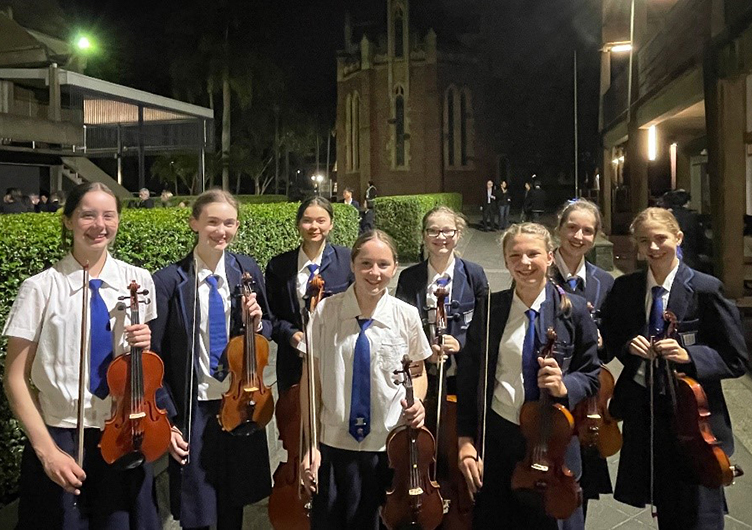
Eva Lusk (10E), Ashley Cleland (10E), Adelaide Chan (8M) Charlotte Cooke (10E), Chiara Jago (8H), Alexandra Mort (10E), Eloise Sayer (7L) and Phoebe Bird (7B)
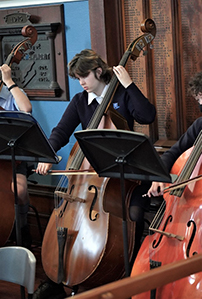
Amelia Howell-Smith (9L) playing Double Bass at the Intermediate Strings Festival
Gillies Ensemble Prize
If you happened to walk past the String Room on Monday this week, you may have heard the magical sounds of our fantastic chamber musicians performing in the annual Gillies Ensemble Chamber Music Competition.
There was precision performances from a wide range of string, wind, and brass chamber groups who performed Mozart, Handel, Bach, Arensky, Corelli, Stamitz and Beethoven as well as music from Hansel and Gretel by Humperdinck, Pirates of the Caribbean by Klaus Badelt, and even Let it go from the movie Frozen, to name a few.
Mr Warwick Adeney was delighted to adjudicate the competition and offered students some invaluable feedback on each groups’ performance. He was thoroughly impressed by the range, depth, and quality of the Chamber Music ensembles at the School, and offered his congratulations to all students and teachers involved in preparing such polished performances.
Mr Adeney awarded four Highly Commended Ensembles:
- String Quartet: Mia Cheng (10B), Isabella Ho (10E), Mackenzie Somerville (10H) and Levi Gao (10G)
- Harp and Cello Trio: Charlotte Parsonage (12G), Michelle Jeong (12W) and Remi Hirayama (12L)
- Brass Quintet: Isabella Peters (12E), Pascal Green (12G), Samara Kohn (12L), Sophia Caposecco (11H) and Ridhma Perera (12L)
- String Quartet: Isabelle Chiang (9H), Olivia Banh (9E), Elizabeth Young (9L) and Shavini Basnayake (9H).
The winning ensemble was a Piano Trio, which featured Irene Shim (12G) on Violin, Michelle Jeong (12W) on Cello, and Isabella Pak (12O) on Piano. They presented an accomplished performance of Alla Pollaca from Piano Trio in F major op.15 by F. Weber and an incredibly emotive rendition of Elegia from Piano Trio no.1 in D minor op.32 by Arensky.
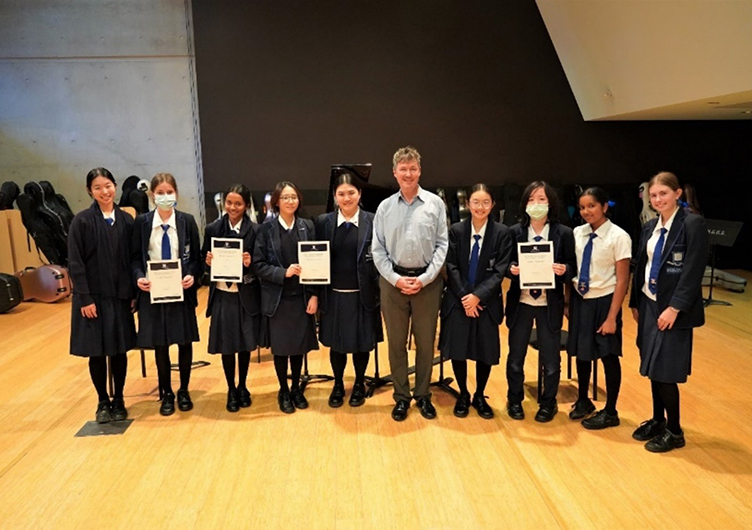
Levi Gao (10G), Mackenzie Somerville (10H), Ridhma Perera (12L), Remi Hirayama (12L), Michelle Jeong (12W), Olivia Bahn (9E), Isabelle Chiang (9H), Shavini Basnayake (9H), Elizabeth Young (9L), with adjudicator Mr Warwick Adeney
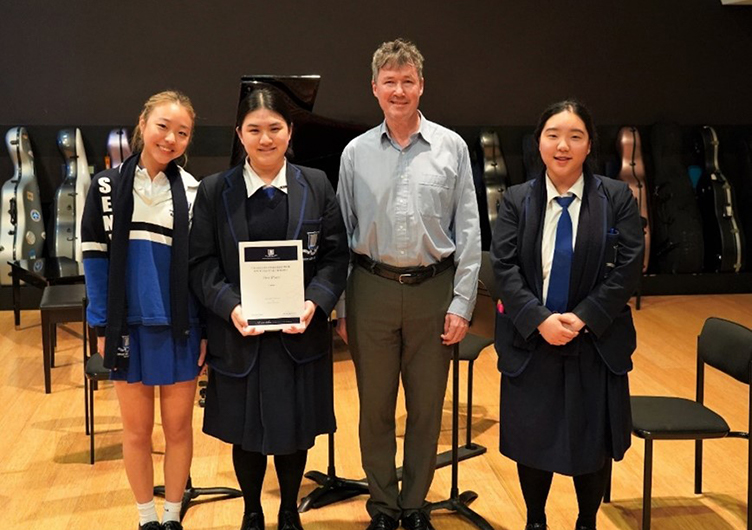
Isabella Pak (12O), Michelle Jeong (12W), Irene Shim (12G), with Adjudicator Mr Warwick Adeney
Gala—Luminescence
On Sunday 14 August, Brisbane Girls Grammar School’s Instrumental Music Department will present the annual Gala Concert in the Great Hall of the Brisbane Convention and Exhibition Centre (BCEC). This year’s Gala will be the first live Gala in three years, so our entire community of staff, students, and families are incredibly excited to produce what promises to be a truly stunning event.
The BCEC Great Hall has hosted some of the entertainment industry’s biggest names and we are very excited to share the space with our audience, to stage a truly remarkable and awe-inspiring concert. We will showcase some of our most gifted musicians, ensembles, and directors throughout the evening.
Luminescence will feature incredible lighting effects, state of the art audio-visual experiences, and the outstanding musicianship of our students. We guarantee you will see and hear new and innovative elements you’ve never before experienced at any previous Gala.
Tickets for Gala—Luminescence can be pre-booked here. Tickets will also be available at the venue on the day of Gala prior to the performance commencing.

Gala rehearsal days
Students and staff have been putting the finishing touches to our Gala—Luminescence production. On Saturday 6 August and Friday 12 August, our performing ensembles came together to put the final pieces of our Gala puzzle together. Without revealing any spoilers, the musicians sound absolutely magnificent and you will be enthralled by their outstanding musicianship. Ticket sales have ramped up over the last few days, so be sure to get in as soon as possible to book your preferred seat, if you haven’t already.
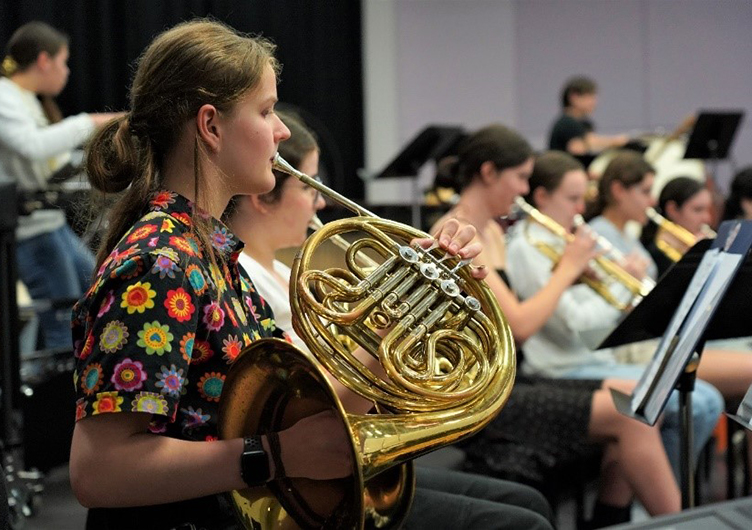
Scout Sommerfeld (10L) rehearsing with Symphonic Winds for Luminescence
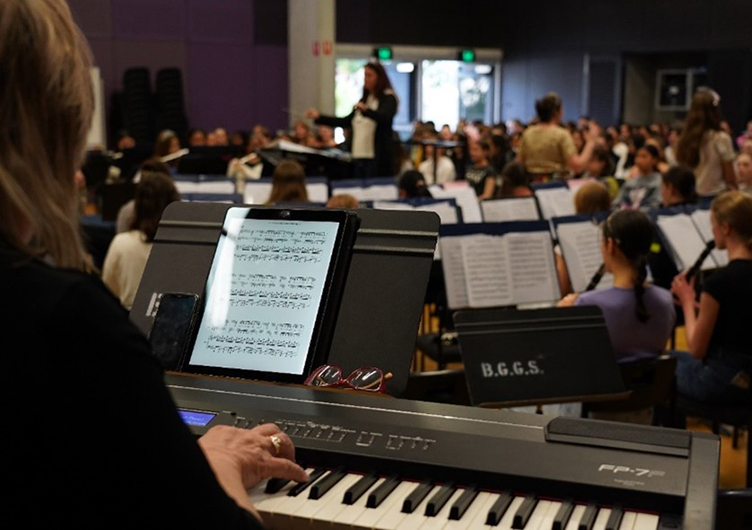
Mrs Kathy Sander (piano) accompanying one of our Gala massed items
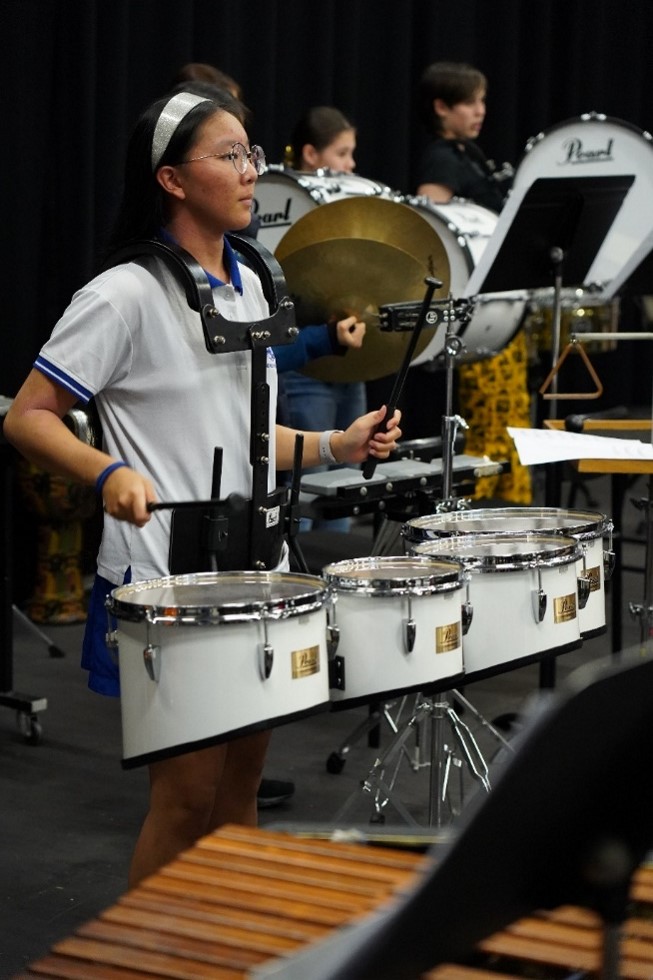
Shinie Gu (9O) rehearsing for Luminescence
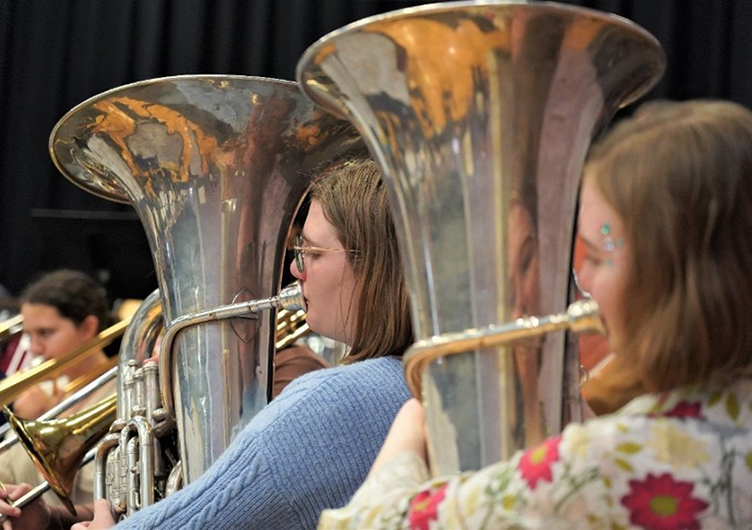
The Gala Tuba section—Pascal Green (12G) and Dorothy Rae (10G)

The Difference Between ‘Lessons’, ‘Rehearsal’ and ‘Practice’ (republished)
In the BGGS Instrumental Music program, there are two major school-based components: lessons and Band rehearsals. The third component, and arguably most crucial, is personal home practice. Students should be engaging in all three elements to maximise their success within the Instrumental Music Program.
As Instrumental Music Teachers, we sometimes see students who engage well in lessons and rehearsals but do not always have the most effective home practice routine. This article aims to outline the function and purpose of the three elements.
Lessons
Instrumental Music lessons form the content delivery component of the program and are delivered in either a small-group or private format. Sometimes, students choose to participate in both. This delivery method is not common across the developed world. In the USA, for example, this component does not exist in many school environments, and students engage only in band rehearsals where there can be as many as 150 students in the room at one time. At BGGS, group lessons usually have an average of 2-4 students per class lesson. This provides an excellent opportunity for students to receive greater individualised attention when compared to a large group format. However, this still only provides teachers the opportunity to ‘steer’ students in the right direction. Imparting specific knowledge, techniques and skills is possible in lessons with the intent of students taking that information home to hone their skill development.
Lessons are not a substitute for home practice, because lessons happen once a week, and usually for only 30 minutes. Students require opportunities alone to refine the skills described, demonstrated, and imparted in their lessons. Learning a musical instrument takes a great deal of skill repetition to put those skills into ‘muscle memory’ or subconscious thought. Much like riding a bicycle—we don’t think about it, we just do it.
Very similar to the concept of ‘homework’ for an academic subject, home practice is crucial for reinforcing knowledge, skills, and capabilities.
Practice
Personal (home) practice is where the conscious thought processes can be made sub-conscious or put into muscle memory. The repetition of skill-building exercises along with reading musical notation, which is similar to reading/learning another language, is essential to the development and improvement of the young musician. An analogy sometimes used with young musicians is to imagine if they only walked on one day each week for 30 minutes—they would quickly lose the ability/strength to walk. Playing a musical instrument works exactly the same way. Perhaps even more so, because performing on a musical instrument employs fine motor skills that require even greater refinement than large muscle groups. This possibly explains why, when we see/hear a great musician, it all seems so natural to them. They’ve worked so hard to put those skills into sub-conscious thought that it does, indeed, become second-nature to them. It can easily be dismissed as a natural/innate talent, but as any successful musician will attest, talent only gets you so far before hard work is required—Nil Sine Labore.
The old saying ‘practice makes perfect’ has been adjusted over the years to variations like ‘perfect practice makes perfect’ or ‘practice makes permanent’.
A thorough, immersive, consistent, and goal-oriented home practice routine can prove revolutionary to the young musician, and often brings about exponential improvement. This said, occasionally the improvement is incremental and can be difficult for the developing musician to distinguish.
Rehearsals
Ensemble rehearsals, like band, orchestra, jazz ensemble, choir, and string orchestra, are considered a vital part of the Instrumental Music Program and are the reason we have lessons and practice. Musicians playing in a musical ensemble is the culminating activity of Instrumental Music. Ensemble rehearsals are not a substitute for lessons or home practice.
Each ensemble usually only rehearses once per week (twice for some senior ensembles), so this extremely limited time is precious. Accumulated ensemble rehearsal time over a whole year adds up to less than two days of practice time. This is an astounding statistic when one considers that out of that limited rehearsal time, the ensemble creates at least four unique performances. Ensembles also put into focus for young people that music-making is rarely about the individual and much more about the collective—‘we’ rather than ‘me’.
It is important to remember that rehearsal time isn’t a student’s opportunity to learn how their part goes—it is a student’s opportunity to learn how everyone else’s part goes. Therefore, coming to rehearsal well-prepared and able to play their part is their gift to the other musicians in the ensemble. This means that a portion of a student’s home practice needs to be dedicated to practising their ensemble music.
In summary:
- lessons—content delivery; small group/private imparting of skills/techniques
- home practice—skill development; coordination; memorisation; individual refinement
- rehearsals—combining the individual efforts into the collective; ensemble skill development; teamwork; piecing the musical ‘puzzle’ together.
What an audience hears at an ensemble’s performance is the culmination of the above three facets. In isolation, the three facets don’t lead to any meaningful outcome. In combination, however, they can provide the foundation for, not only a successful Instrumental Music Program but a thoroughly engaging activity that students can enjoy for a lifetime.
MSG News
The next major music event is, of course, the Gala Concert on Sunday. As the venue staff will look after ushering, we have no specific role except to help pack up at the end of the night. Music staff will have been on site since early morning and would love any assistance you could offer—please sign up at https://volunteersignup.org/YCDHA
And then, mark your diaries for our inaugural Soirée on 8 October!

Looking Ahead
- Gala Rehearsal Afternoon—Friday 12 August
- BGGS Gala Concert Day—Sunday 14 August
- Vivaldi Service Performance—Tuesday 16 August
- Incoming Parent-Student Dinner (Little Big Band)—Thursday 18 August
- Junior Strings Festival—Tuesday 6 and Wednesday 7 September




